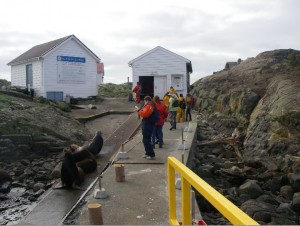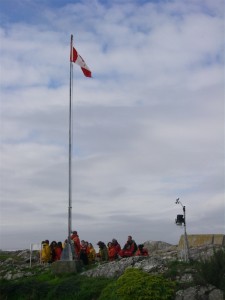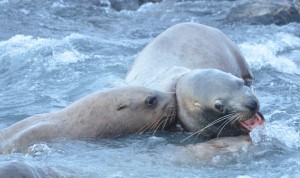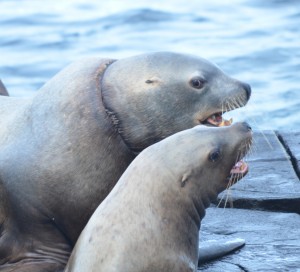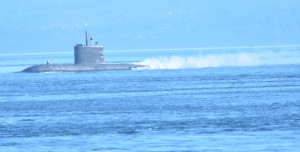After an overcast and partially foggy start to the day, the sky cleared in the early afternoon. Winds were less than 10 knots all day from the west-southwest turning to east in the evening. The barometer rose slowly all day and reached ~ 2022h PA. The forecast is for light winds becoming easterly 10 to 15 knots early Wednesday morning. It is expected to clear in the morning and be nice on Thursday.
Only four whale watching vessels were observed in the protected area today. They all treated the protected area with respect and drove slowly and carefully. Several pleasure craft went through, one at high speed, right through the area where there were 50 to 100 sea lions in the water. The other sports fishers were much more careful.
A couple of miles to the south of Great Race, a Canadian sub was observed heading out to sea and then a few minutes later, literally steaming back to shore.
I had the opportunity to work with one of Catrin Brown’s first year biology students today. They have just finished studying ecology, so came well armed with vocabulary and concepts and were keen to soak up knowledge gained firsthand on this little biological hot-spot.
We saw evidence of food chains and food webs everywhere from Canada Geese grazing on the grass, to evidence of predation on gulls and predation by gulls. We observed the thick climax kelp forest that rings the islands and reefs and saw evidence of intertidal grazers like chitons and phytoplankton feeders like clams and mussels. We didn’t spot the sea otter that is usually here but had plenty of other marine mammals and evidence of their dining and moulting habits in the form of fish bones, fish otoliths and hair, fur and pelage (from the spring moult of the Northern Elephant Seals).
We talked about the trophic level of different types of Killer Whales and the need for protection of critical habitat for recovering species at risk. The southern Resident Killer whales are of course highly endangered and are really dependent on strong Chinook Salmon runs while Biggs Killer Whales feed one trophic level up and eat marine mammals like seals and sea lions that in turn eat salmon.
We talked about the timing of births, mating, nursing and parental care in different species and about different symbioses including parasitism ( nice worms present in seal poop) and mutualism. We talked about phenology and seasons being dominated by different types of fish and about migrations.
We even touched on the great detritivore and decomposition loops. The carbon sink that is mediated by the microbial pump that transfers carbon to deep sediments. It was an ecologist’s kind of an afternoon, a living show and tell, a time for discovery and questioning which will hopefully on reflection, lead to some deep learning.
- Pearson College Biology students head up the jetty past California Sea Lions and Northern Elephant Seals.
- Pearson College Biology students from around the world gather under the Canadian flag at Race Rocks to start their ecology field trip on Great Race Island.
- The larger sea lion is “necklaced”, that is he has a plastic strap around his neck and it is embedding into his flesh. Two small animals were observed in close contact appearing to try to help. This animal is here daily near the house and is a good candidate for humane removal of the strap by Dr. Martin Haulena and team from the Vancouver Aquarium.
- Kettle’s on.
Chores were routine and it is great to have company.

